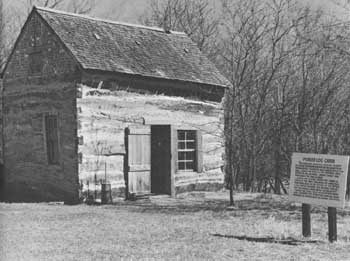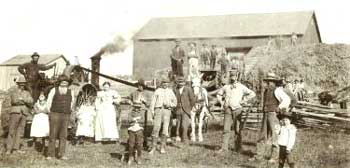






Survey of Historic Sites and Buildings
 |
HOMESTEAD NATIONAL MONUMENT Nebraska |
 |
| ||
This monument commemorates the free land policy that governed the settlement of the Western Plains and the hardy pioneers who endured frontier conditions while settling the West. Vast amounts of cheap land induced native and foreign-born emigrants to join the vanguard of the westward expansion of the United States. Free land as a reward to pioneer settlers for their part in converting undeveloped lands into farms was gradually recognized by law. Disposal of the public domain to private owners, partly to provide governmental revenue, continued until well after 1900.
In the decades just prior to the Civil War, Congressmen newspaper editors, political leaders, antislavery groups, and individuals cried out for free land. Nonsectarian both in origin and during its early history, the homestead movement attracted diverse support as it gained force and popularity. First minor, and later major, political parties advocated free homesteads in their platforms.
 |
| Restored Palmer-Epard log cabin at Homestead National Monument, typical of thousands of such homes built by sodbusters. |
Between 1840 and 1860 the movement for a homestead law slowly crystallized. At first it received some support from the Southeastern States. As the alliance between the agrarian West and the industrial East grew stronger, however, the slave States increasingly opposed homestead proposals and several bills failed of passage in Congress.
Finally, in 1862, President Lincoln signed the Homestead Act, under which any citizen or citizen-to-be could obtain 160 acres of unappropriated Government land free of charge, except for a small filing fee. To become full owner, the settler was obligated to live on the land and cultivate it for 5 years.
Later acts made land more easily obtainable, especially for Civil War veterans. At the end of the war thousands of men sought a livelihood in a country disrupted by 4 years of upheaval. Many took advantage of the free public lands offered by the Homestead Act. Europeans were lured to seek new homes in the United States because they could obtain a free farm, as well as enjoy the other opportunities of a democratic Nation. The influx of land seekers-aiding significantly in peopling Kansas, Nebraska, the Dakotas, and Montana—was a major factor, along with industrial development, in doubling the Nation's population during the 40 years following passage of the Homestead Act.
 |
Homestead National Monument is on the site of Daniel Freeman's homestead, located on a T-shaped quarter section. Freeman was one of the first applicants to file under the Homestead Act; he filed Homestead Entry No. 1 at the Brownville, Nebr., Land Office during the early hours of January 1, 1863, the day the act went into effect. Several applications were filed at the other 29 Land Offices as early or earlier than Freeman's. Freeman and his wife are buried near the monument's eastern boundary, the highest point on the homestead. From the gravesites the entire Freeman homestead may be viewed.
In 1936 Congress designated the Homestead National Monument of America as "a proper memorial emblematical of the hardships and the pioneer life through which the early settlers passed in the settlement, cultivation, and civilization of the great West." On exhibit at the National Monument are pioneer objects and graphic displays of life during settlement of the public domain. The Palmer-Epard homestead cabin, erected in 1867 in a neighboring township, has been moved to the monument. Its furnishings and tools suggest the pattern of life followed by the homesteaders on the tall-grass prairie. A 1-mile self-guiding trail, beginning at the visitor center, leads to the Palmer-Epard and original Freeman cabins and the sites of later Freeman buildings, including the brick home of 1876. Side trips may be made to the graves and the site of Squatters Cabin, near Cub Creek.
 |
 |
http://www.cr.nps.gov/history/online_books/prospector-cowhand-sodbuster/sitea4.htm
Last Updated: 22-May-2005